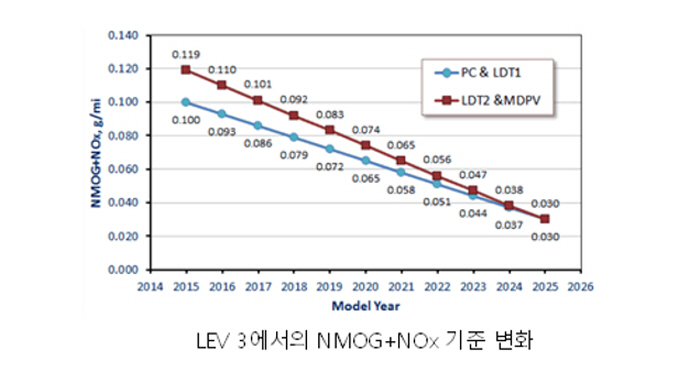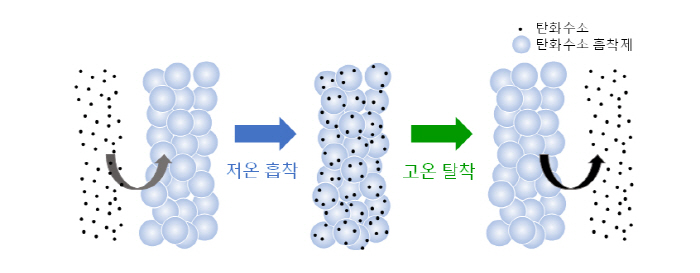A groundbreaking technology was developed to remove pollutants from gasoline (and hybrid) vehicles.
Professors Jungkyu Choi and Sangkyu Kwak’s group developed the technology through an approach which cross-fertilized the insights from both experimental and theoretical methodology.
The research results were published in Applied Catalysis B: Environmental, an international journal in the field of catalysis.
The amount of harmful substances in exhaust gas is expected to be effectively reduced.

▲ (From left) Professor Jungkyu Choi (corresponding author), Professor Sangkyu Kwak (corresponding author), Jinseong Kim (integrated master-doctoral degree program, first co-author),
Jaehee Shim (integrated master-doctoral degree program, first co-author), and Doctor Jinchul Kim (first coauthor) of the Department of Chemical and Biological Engineering.
Jinseong Kim and Jaehee Shim, students in the integrated master-doctoral degree program of Professor Jungkyu Choi’s group, and Doctor Jinchul Kim of Professor Sangkyu Kwak’s group of the Department of Chemical and Biological Engineering developed a copper-impregnated zeolite adsorbent that can effectively remove hydrocarbons contained in the exhaust gas of gasoline and hybrid vehicles. The researchers not only presented a method of synthesizing a high-performance hydrocarbon adsorbent but also investigated the roles of copper species in improving the performance of the hydrocarbon adsorbent by combining insights from experimental and theoretical methodologies.
As global warming becomes severe, the regulations set by climate change conventions are intensifying each year. Vehicles account for about 28% of the total exhaust gas causing global warming. While eco-friendly vehicles should ultimately be adopted, internal combustion engine vehicles (including hybrid vehicles) will remain in use for several decades, and regulations regarding exhaust gases are being intensified to make the vehicles cleaner. For example, the LEV3 environmental regulations of the United States aim to reduce the emission of NMOG (Nonmethane organic gas) + NOx to 0.03 g/mile (Figure 1).

▲ Figure 1. Change of the LEV3 exhaust gas regulations.
Gasoline vehicles are equipped with a three-way catalyst that can convert the harmful substances contained in exhaust gas. The three-way catalyst is capable of subjecting the CO, NOx, and HC (hydrocarbons) included in the exhaust gas to simultaneous reactions, efficiently converting them to the environmentally stable N2, CO2 and H2O. However, for several minutes after starting the engine of a vehicle that has been parked for a long time (during the cold-start period), the catalyst fails to be activated and to convert most of the harmful substances, which are therefore released to the atmosphere. This drawback makes the three-way catalyst alone unable to satisfy the rapidly intensifying environmental regulations, and creates the need for an exhaust gas treatment device that can assist the three-way catalyst.
A hydrocarbon adsorbent is an effective method for solving the problems of the three-way catalyst. A hydrocarbon adsorbent adsorbs the untreated hydrocarbons during the cold-start period and then desorbs them when the temperature is sufficiently high to activate the three-way catalysis and convert them to CO2 and H2O (Figure 2). The hydrocarbon adsorbent can only be effectively applied if it can adsorb a large amount of hydrocarbons at a low temperature and desorb them at a high temperature. It should also possess high hydrothermal stability. To develop a hydrocarbon adsorbent satisfying the abovementioned conditions, the research group employed zeolite as the base material. Zeolite has a uniform microporous structure formed by the regular arrangement of atoms, and it exhibits a high specific surface area (Figure 3). However, when zeolite is used alone, the types of hydrocarbons that can be adsorbed are limited by the size of its micropores.

▲ Figure 2. A schematic diagram illustrating the role of a hydrocarbon adsorbent in assisting a three-way catalyst.

▲ Figure 3. A schematic diagram showing the basic structure of MFI zeolite and the shape of the porous channel.
To solve the problem, the research group impregnated cooper in a zeolite microporous material and thereby developed a hydrocarbon adsorbent that can adsorb a large amount of hydrocarbons, not only those of high molecular weight (e.g. toluene) but also those of low molecular weight (e.g. propylene). Based on infrared spectroscopy, the research group experimentally confirmed that the amount of propylene adsorption was highly correlated to the amount of cuprous (Cu+) ions. In addition, the research group experimentally discovered that the oxidation temperature of the hydrocarbons is lowered by the small copper oxide particles. Furthermore, the researchers applied computer-based Density Functional Theory (DFT) calculations to investigate the experimentally acquired correlation via computational chemistry (Figure 4). After creating a model simulating the physicochemical properties of zeolite, the DFT calculation was used to predict the interactions between a particular molecule and the zeolite.
*Zeolite: An inorganic crystalline material of silicon oxide in which some of the silicon atoms are substituted with aluminum atoms. Zeolite has pores smaller than 1 nm. Over 200 independent zeolite structures of have been reported according to their unique crystal structures, and these structures are represented by three-letter codes (e.g. MFI (Zeolite Socony Mobil-five), CHA (Chabazite), DDR (Deca-dodecasil 3 Rhombohedral), and LTA (Linde Type A)). Zeolites are widely used in various fields as ion exchangers, catalysts, catalyst carriers, adsorbents, and membranes.

▲ Figure 4. The MFI structure cluster for calculating the binding energy through the DFT calculation; the cations included in the structure; and the binding energy of the individual cations to propylene.
The research group found that the binding energy between propylene and the cuprous (Cu+) ions was high even in the presence of many water molecules. The computational results proved that the amount of copper (Cu+) ions is closely correlated to the amount of the propylene adsorbed experimentally. The hydrocarbon adsorbent developed in this study, with its high performance and high thermal stability, is expected to be able to effectively reduce the emission of harmful substances in the exhaust gas of vehicles by supplementing the weaknesses of the three-way catalyst. The research group performed various analyses to investigate the effects of copper on the performance of the hydrocarbon adsorbent and, through doing so, presented future directions of hydrocarbon adsorbent development.
Professor Choi explained the importance of the research as follows: “Jinseong Kim and Jaehee Shim persevered with the study to achieve the development of the copper-impregnated zeolite-based hydrocarbon adsorbent featuring optimal performance. This was possible because their goal was to develop a technology that is applicable to energy-efficient hybrid and internal combustion engine vehicles, which will remain the major products in the automobile market for decades to come. Moreover, when the zeolite-based adsorbent technology is applied to various industrial areas, harmful substances can be reduced in a more energy-efficient manner than at present.” Professor Kwak commented on the significance of the research, “We compared the hydrocarbon adsorption capabilities of the zeolite-based adsorbent according to water content conditions. This has provided a theoretical foundation for developing adsorbents for removing hydrocarbons through molecular simulation.”span>
The study was supported by the Hyundai Motor Company, the Mid-Career Researcher Program (2020R1A2C1101974) through the National Research Foundation of Korea (NRF), the Korea Research Institute of Chemical Technology (KRICT), and the Korea Institute of Science and Technology Information (KISTI). The article was published in Applied Catalysis B: Environmental (Impact Factor: 24.319 and JCR top 2.1% journal in chemical engineering), a globally renowned journal in the field of catalysis.
- Article : Unveiling the elusive roles of Cu species in determining the hydrocarbon trap performance during cold start in Cu-impregnated MFI type zeolites



